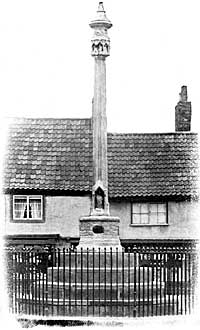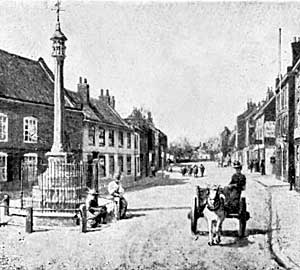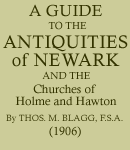< Previous | Contents | Next >
The Beaumond Cross

Beaumond Cross.
Walking from the Market Place, through the Saracen's Head Yard, into the street beyond, we come to The Beaumond Cross.
This stands at the junction of five streets or roads, and the place has been known as The Beaumond, or Le Beaumond, from time immemorial, being so named in a deed as early as 1310. The first documentary mention of the Cross itself ("Beaumond Crosse") hitherto discovered is in a deed of 1367. The Cross, then, derives its name from standing in the Beaumond, where it was probably erected, judging by its architecture, in the early part of the fourteenth century.
The Cross, as it now stands, consists of an octagonal plinth some two feet and a half in width and height, which surmounts a pile of steps erected about a century ago. From this plinth rises the shaft, some thirteen feet or so, delicately tapering from a diameter of about eighteen inches at the base to some twelve inches at the top, wrought with clustered shafts and fillet mouldings. A canopied niche at the base shelters a saintly figure, now unrecognisable, while the top is surmounted by an ornamental octagonal capital, having on each side a niche containing a small seated figure, all much weathered. On this would originally stand a stone crucifix, probably two or three feet high. Until about a hundred years ago the remains ended at the flat top of this capital, but in 1801 a conical stone cap was added, and a weather vane was until recently upheld by the elegant pillar which the artist's eye and the mason's craft combined to erect as a chaste and fitting support for the emblem of the crucified Saviour.

Of the actual origin of this Cross nothing definite is known, though Mr. Wm. Stevenson has argued ably in favour of its being one of the "Queen Eleanor" Crosses, a theory first suggested by him, and the most probable of the several hitherto advanced. The Queen died in 1290, at Harby, between Newark and Lincoln, and, as the cortege started from Lincoln on its sad journey to Westminster, and was probably accompanied all the way by the Bishop of Lincoln himself (seeing that he officiated at the funeral ceremony at Westminster afterwards), it most likely travelled by way of Newark, practically the Bishop's own town, where it could use the hospitality of his Castle, and, possibly passing out by the spot where the Cross now stands, went London-wards by Sewstern Lane.
However that may be, Beaumond Cross is essentially one of the old land-marks of the town, and is remembered by Newarkers in all parts of the world, being hallowed by the associations and vicissitudes of six centuries of the old town's life. Surviving the desecration which befel its Cross, this graceful shaft has stood through all the turmoil of the Civil War, when Newark was indeed taking its part in the making of History, down to more peaceful times when, with clatter of hoof and blast of horn, the gaily-painted coaches which carried our grandsires to "Town" rattled past where the sign-board affixed to the adjacent street corner still points "To London." Through the hubbub of political elections, through street brawl and riot, through national rejoicings and municipal pageants, the time-worn shaft of quiet grey stone still stands as a reminder of the crowded memories of the past.
